Abstract
The existence of specific factors which influence practice of physical activities in adults, and improvement of working places and conditions, after controlling for age and other characteristics. The awareness of the importance of specialized guidance in the field of physical education and kinetotherapy, that can help adults improve their knowledge of it. Organized exercise should result in increased quality of life and professional performance. Research design was cross-sectional, results were based on classical methods of investigation: scientific documentation, questionnaire-based survey, and graphical interpretation. The survey was carried out in 2015 based on a questionnaire designed by the authors, with 20 questions chosen so that the answers were as objective as possible, leading to a high rate of accuracy. There were 42 subjects (59.52% men and 40.47% women), aged between 28 and 59 years which are teaching staff, researchers and auxiliary staff at the University of Bucharest. The study showed that physical maintenance activities elicit most interest from 80.95% of participants, followed by sport activities 26.19%, and therapeutic activities 19.04%. The age distribution is: 45-50 years old 28.57%, 40-45 years old 19.04%, 25-30 years old 16.66%, 35-40 years old 11.90%, 30-35 years old and 50-55 years old both with 9.52%, with 55-60 years old having only 4.7%. Results confirm assumptions, identifying motivational factors of practicing physical exercise in an organized setting, showing the psychological and social reasons that determine adults to do sport.
Keywords: Perceptionadultsphysical activities
Introduction
People’s health is the most important asset of every country, and is worsened by many factors.
Unfortunately, when it comes to fighting against factors of aggression and health disruption, people and
health institutions do not have enough resources to meet three conditions: accessibility, true efficiency
and lack of adverse effects (Dumitru, 2007).
In time, enough scientific arguments were presented about the loss of lean body mass and
continuous growth of fat deposits in the human body. This transformation is proved to be accelerated by
diet and sedentary behavior, causing major decreases of physical activities (Ettinger et al., 2006). In
Romania, Epuran paid attention to this problem and defined the psychomotricity as “the expression of
maturation and integration of motor and physical skills at the level pretended by the good integration of
individuals” (Albu et al., 2006, p. 9).
Physical activity is not only a means to maintaining good health, but also an essential condition
that allows our body to function efficiently (Bogdan and Bogdan, 2009).
During his evolution, the modern man interfered decisively with respect to using his own physical
energy. The best example is frequent use of cars. Increases in life comfort led to clear decreases in
physical effort and the creation of “health consuming” modern man (Pehoiu, 2003).
Basis
There are factors known to have a negative influence on human health, among which the most
dangerous are drugs, alcohol, smoking, food excess, and also a sedentary lifestyle, doubled by stress. We
notice that men are far from understanding the positive influence of practicing physical exercises for the
body and this healthy lifestyle should be promoted through social policies starting with children and
finishing with the seniors.
Respiratory problems, hearth diseases, osteoporosis and diabetes which now affect younger
people, are the effect of weak or missing relevant public policy measures. For example, WHO estimates
that every year, the effect of physical inactivity is the reason for 1.9 million premature deaths worldwide
and almost 1/3 of them are in the 53 countries of the European region. Several years ago, the European
Heart Network (EHN), with British Heart Foundation (BHF) published European statistics of
cardiovascular diseases, showing that these generate almost 49% of deaths, of which 42% were located in
the European Union. Incidence of cardiovascular diseases and their death toll are decreasing in Northern
and Western European countries, while in the Eastern European countries they are either decreasing very
slowly, or even increasing.
Most specialists point out the fact that mental and physical health represents an endless process.
Motivation for the physical activity is complex, through a larger range of outcomes, self-respect, personal
perception, auto-control, discipline, responsibility, body image, physical state, communication, bonding,
general happiness, success at work, and a better health state (Demeter, 1991).
Assumption
Participation in some institutional non-formal programs organized and assisted by specialists,
where maintenance physical activities are carried out, can represent the basis of a balanced lifestyle.
The subjects
This research was carried out on 42 subjects, 59.52 % men and 40.47 % women, aged between 28
and 59 years. Our research took place in the Centre of Psychomotor Counselling and Quality of Life
Increase for academic staff and support employees. It was created in 2011, with the decision of the Senate
of the University of Bucharest, with the aim that academic community benefits from the services of this
center for free, under the supervision of 5 specialists with extensive professional experience in the fields
of physical education, sports and kinesiotherapy.
The Center of Psychomotor Counselling has 6 specialty rooms and a gym, where the following
disciplines are practiced: aerobic gymnastics, maintenance gymnastics, tae-bo, cardio activities, ballroom
dance, Latin dance, fitness, bodybuilding, table tennis, physiotherapy, kinesiotherapy.
The sample consisted of educated adults, and we tried to determine the factors that can influence
motivation within the academic staff for the systematic practice of physical activities.
Methods
Our research was cross-sectional, based on the use of classical research methods: scientific
documentation, collecting data, research, data processing, graphical representation and interpretation. The
research was completed in 2015 and consisted in administering a questionnaire. We mention that
according to the Helsinki Declaration, Amsterdam Protocol and Directive 86/609/EEC, the approval of
the Ethics Commission of the University of Bucharest regarding research on human subjects was
obtained and also, the subjects' consent for their personal participation in the research.
Research
The questionnaire, presented in the Appendix, has 20 items, which targeted 8 main issues:
professional status within the institution (teaching staff, researcher, auxiliary staff), work location and
favorite physical activities; time preferences and days dedicated to physical activities, type of guidance
and the approach based on proficiency levels of attendees; importance of the social factor, intensity of
effort; accomplished goals, benefits of regular exercise under professional guidance; proposals for the
upgrading and diversification of the available equipment.
Results
Preliminary results showed that the interest in participating in physical and sports activities
depends on the job and educational level. There is a strong interest in physical movement from those
whose activity implies intense physical effort.
The socio-professional structure of the subjects is: academic staff 50.0%, auxiliary teacher
40.47%, researchers 9,52 % (Figure no 1), 59.52 % are men and 40.47 % women, aged between 28 and
59 years (Figure no. 1).

The distribution across age groups is: 45-50 years 28.57 %, 40-45 years 19,04%, 25-30 years
16.66%, 35-40 years 11.90%, 30-35 years and 50-55 years are equal with a percentage of 9.52 % and 55-
60 years 4.7 % (Figure no. 1). When it comes to the working place, 61 % do their activity very close to
the Counselling Center. For the remaining 39 % the working place is fairly far from the Center (Figure no. 2).

The highest percentage (55.9%) is represented by people that sit at a desk, followed by who stand
in the classroom or laboratory (17.8 %), with intensive use of the blackboard. 12.1% use the blackboard
and move in the classroom or laboratory (chemists, biologists, geologists). Those who do field work
(geologists, geographers, biologists, auxiliary teachers etc.) (10%), and those whose work involves other
types of activity (4.2 %) are the least numerous. (Figure no. 3).
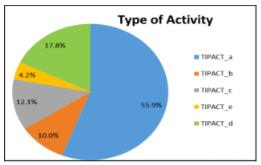
83.33 % of the subjects prefer exercising in the afternoon, between 14:00-20:00 (Figure no. 4).
47.61 % participated two times a week, 28.57 % three times a week, 11.90% once a week, 7.14 % four times a week, and 4.76 % five times a week (Figure no. 5).
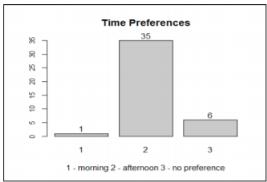
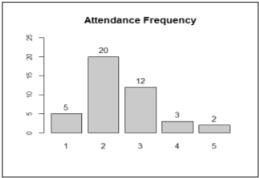
The specialists’ contribution is important because 69.04 % of the subjects prefer to be trained by a
qualified teacher, 21.42 % want to practice on their own following a special program learned initially
with the teacher, and 9.52 % prefer to diversify by adding new exercises found on different fitness sites
based on their knowledge (
mainly those who practice aerobic gymnastics, maintenance gymnastics, tae-bo and aerobics step. 57.14 % want to work out both in groups and individually (
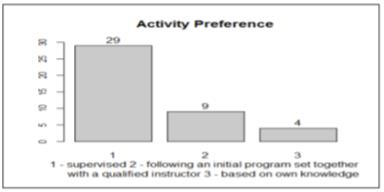
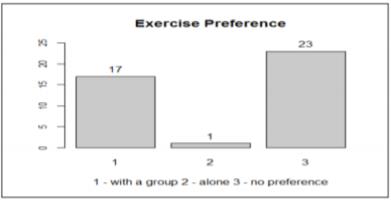
The fact that most subjects prefer alternate intensity (59.52 %), with 26.19 % preferring moderate
intensity, shows that the subjects do not have a physical base that can sustain a longer effort. Thus the
high preference for the following disciplines: table tennis, maintenance gymnastics, aerobics, fitness,
bodybuilding, dance (Latin, ballroom), medical gymnastics. (Figure no. 8 and Figure no. 9).
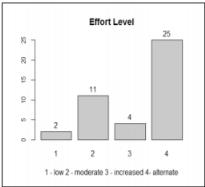
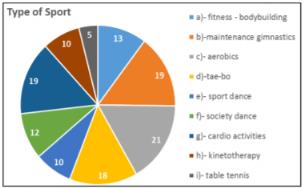
The main participation cause is the improvement of the physical condition, primarily in physical
maintenance activities 80.95 %, followed by sports activities 26.19 % and therapeutic activities 19.04 %
(Figure no. 10). Furthermore, 45.32 % of the subjects realize that the psychical and physical benefits are important for the professional performance (Figure no.11).
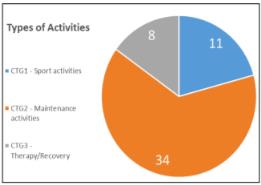
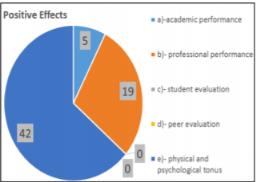
When it comes to health impact, participants demonstrate a high level of knowledge regarding the
relation between the physical exercise and health, and the influence of doing physical exercises in
prevention, treatment or cure of some diseases (e.g. osteoporosis, hearth disease, diabetes, obesity).
Results confirm the fact that organized practice of physical exercises in an institutional setting
becomes an opportunity to increase the number of acquaintances (80.95%) , more optimism (76.19 %),
increased socializing thanks to the common subjects and preoccupations (71.42 %) a positive psychical
state (71.42 %), becoming less isolated, initiating institutional collaborations (23.80%) (projects,
scientific meetings etc.) and extra institutional collaborations (19.04%) (cultural sportive activities, free time recreation etc.) (
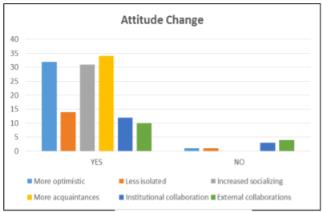
The awareness of the importance of counselling, and the accumulation of more knowledge in this
domain made us conclude that our objectives were met. We noticed that 97.61 % of our subjects formed a
positive attitude towards physical exercises and physical effort, 54.76 % consider that this facility helped
them to adapt easily to the requirements of their daily activity. For 42.85 % of those inclined to have
morpho- functional limitations, extreme stress, psychical shocks, stereotypes etc., the perceived control
helped them overcome their inhibitions as they can practice different physical exercises, in group and
individually. Those who had physical problems (23.80%) such as traumas or an unhealthy lifestyle,
received stimulation from programs. 21.42 % noticed that respecting the rules of good practice helped them balance their lifestyle (
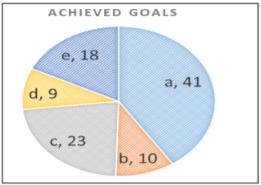
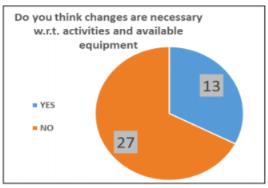
There is a significant percentage of 64.28 % who declare being happy with the programs and
equipment. We can claim that those make up some essential aspects: the wish for movement, the quality
of the programs and specialists can compensate the need for more sophisticated equipment and
accessories. A percent of 30.95 % represented those who pointed out the need for some enhancements in
the material base, especially regarding the equipment and the accessories for the bodybuilding and fitness
disciplines (
Conclusions
The results of the study confirm its assumptions. The analysis of scientific and methodological
literature shows that, although achievements in the physical education and kinetotherapy are obvious,
there are still some unsolved problems regarding the formation of perceptions concerning educational
values of the physical exercise in general and their significance, the psychomotor and social acts, which
help the adult development, even among people with high levels of education.
Answers showed that all participants consider that practice of physical activities for the
maintenance of physical and psychical health and their social impact are important.
It is confirmed that the subjects are aware of the positive impact of physical movement on the
daily tasks, and on personality traits such as courage, responsibility, perseverance, critical spirit,
initiative, organizational skills, correctness, will and optimism.
Results of this study allowed us to determine, based on its interests and motivations, the factors
and the influence of physical activities on the participants, individually and as a whole. Among these
motivations, the most important is the creation of a positive attitude towards physical exercises and
physical effort to the benefit of health (97.61 %), followed by the maintenance of a physical condition
suitable for performance of daily tasks.
We consider that it would be important to expand this type of study at national level, regarding the
effects of practicing physical and sports activities on maintenance of health and improvement in life
quality, for the academic communities, and improve their opinion on the need of creating Psychomotor
Counselling Centers in higher education establishments, as a key social facility.
Appendix 1. QUESTIONNAIRE (lifestyle analysis)
Please accept to join the target group for a case study by filling out this questionnaire, with the purpose of improving the Psychomotricity Counselling Center. Its results will be published in an academic journal. We need you to provide honest answers and we need you to be aware of certain issues raised in our study.
a) first part of the day (8-14) b) second part of the day (14-20) c) it does not matter
1/a week 2/a week 3/a week 4/a week 5/a week
c) based on my own knowledge a) supervised by qualified staff b) after a schedule set initially together with a qualified staff
a) life partner (husband/ wife) b) children c) life partner and children
11.What type of effort intensity do you prefer during sports activities:
a) low intensity b) moderate intensity c) high intensity d) alternate intensity
12.What type of sports activity would you like to practice (you can choose multiple disciplines)
a) fitness/bodybuilding e) Latin dance b) maintenance gymnastics f) ballroom dance c) aerobics g) cardio activities d) tae-bo h) medical gymnastics (kinetotherapy)
i) table tennis j) others (mention)……………..
1 year 2 years 3 years 4 years 5 years 14.What type of activities made you choose the Counselling Center services:
a) sports activities b) maintenance activities c) therapeutic activities (recovery) 15.By regularly attending the Counselling Center programs, have you noticed positive effects on:
a) family life ? b) social life in general ? c) life in the academic community?
References
- Albu C, Albu A, Vlad TL, Iacob I. (2006). Psihomotricitatea.The European Institute Publishing House, Iaşi, 9
- Bogdan V, Bogdan A. (2009). The role of the sanogenetic the activities of the physical. Why should we wait until you may be too late? Palestrica Mileniului III; 35 (1): 48-52
- Demeter A. (1991). The muscular joy: Sports For All Publishing House, Bucharest.
- Dumitru G. (2007). Romania connects slowly at the european steps of health promotion in motion, Palestrica Mileniului III; 30(4): 213-217
- Ettinger HW, Wright B, Blair NS. (2006). Fitness after 50. US: Human Kinetics Publishing House,
- Pehoiu C. (2003). Physical education and sport in the prevention of the negative consequences of modern life. In the annals of the University of Oradea:The beam physical education and sport, 652-665
Copyright information

This work is licensed under a Creative Commons Attribution-NonCommercial-NoDerivatives 4.0 International License.
About this article
Publication Date
25 May 2017
Article Doi
eBook ISBN
978-1-80296-022-8
Publisher
Future Academy
Volume
23
Print ISBN (optional)
-
Edition Number
1st Edition
Pages
1-2032
Subjects
Educational strategies, educational policy, organization of education, management of education, teacher, teacher training
Cite this article as:
Aducovschi, D., Dumitrescu, R., Sakizlian, R., Sakizlian, M., Oţoiu, A., & Slăvilă, M. (2017). Adult Motivation for Practicing Physical Activities in Academia. In E. Soare, & C. Langa (Eds.), Education Facing Contemporary World Issues, vol 23. European Proceedings of Social and Behavioural Sciences (pp. 1542-1550). Future Academy. https://doi.org/10.15405/epsbs.2017.05.02.190

